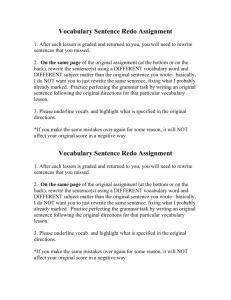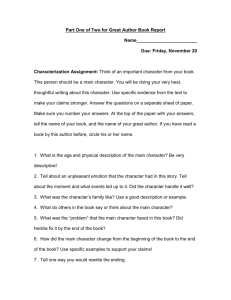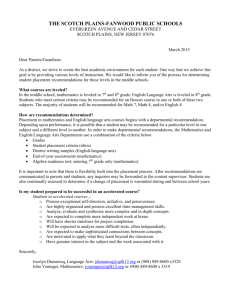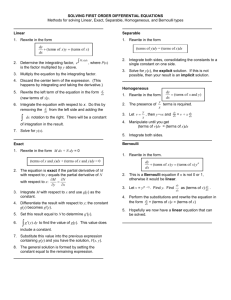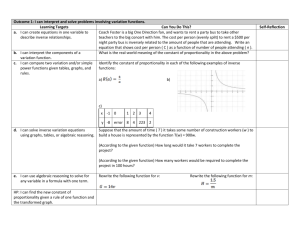computerized placement assessment guide
advertisement
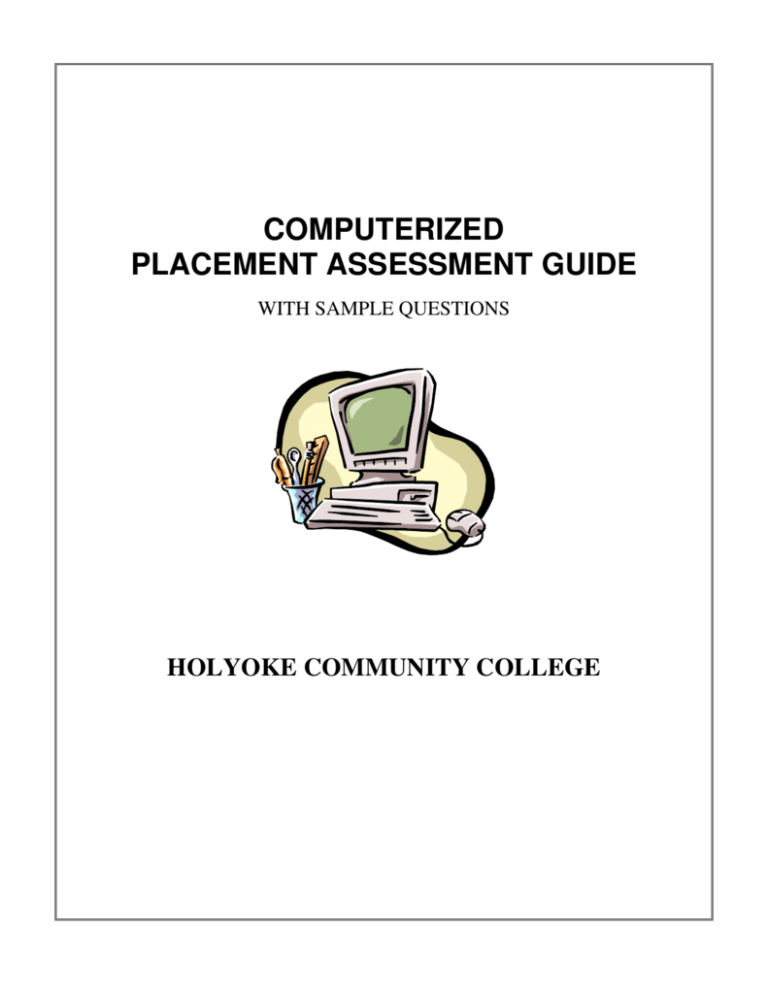
COMPUTERIZED PLACEMENT ASSESSMENT GUIDE WITH SAMPLE QUESTIONS HOLYOKE COMMUNITY COLLEGE Student Guide Welcome to Holyoke Community College’s Educational Planning Program. All new students receive a personalized assessment and educational planning session following their admission to the College. Please read the following to understand the reasons for your assessment and the procedures you must follow. Assessment Policy The Commonwealth of Massachusetts requires all new college students to be assessed in the basic skills of reading, writing, and mathematics and placed in classes accordingly. Holyoke Community College administers placement assessments to all newly admitted students before they schedule classes for their first semester of study with an educational planner. Students who do not demonstrate college-level basic skills are required to take developmental courses designed to improve the reading, writing and mathematics skills needed to be successful in college. For all students newly entering the college in a certificate, degree, or transfer program or in a course for which a placement assessment is needed: • Placement assessment in reading and writing and mathematics is required. • Based on placement test scores, all students will be placed in appropriate developmental (0-level) English and mathematics or college level courses. Students will not, however, be restricted to 0-level courses in other disciplines as a result of placement scores. • No credit toward graduation will be awarded for 0-level developmental courses. • Students with documented disabilities may receive appropriate assessment accommodations upon request. Students are notified of the dates and locations of placement assessment and educational planning by the Admissions Office after being admitted to the College. For Further Assistance If you have any additional questions or concerns about Computerized Placement Assessment, please see the test administrator in FR 271 or call 552-2055. New students should call 552-2001 for an appointment. 2 The Purpose of the Assessment Holyoke Community College administers computerized tests in reading, writing, and mathematics using the Computerized Placement Tests (CPTs) published by the College Board to obtain information about your skill accommodation in these subjects (reading, writing, and mathematics.) By assessing your ability levels in these areas, the CPTs help to determine the English and mathematics courses most appropriate for you at this time. Following your assessment, you will see an educational planner who will help you choose your courses. Taking the Assessment The Computerized Placement Tests are administered on a personal computer. You will read the instructions and the questions on the computer screen and will select your answers using the computer keyboard. You may take as long as you need to complete each test. The tests are untimed. Each assessment is designed with adaptive assessment techniques. This means that the computer automatically determines which questions are presented to you based on your responses to prior questions. This technique “zeroes-in” on just the right questions to ask you without being too easy or too difficult. The greater your demonstrated skill level, the more challenging the questions presented to you. Special Arrangements for Students with Disabilities If you have a documented disability or temporary disabling condition that will prevent you from taking the tests under standard conditions, inform the Test Administrator before taking the test or contact the Office for Students with Disabilities (413-5522417) prior to your testing appointment. What to Take with You to the Test On the day of the test, be sure to bring a photo identification card (or driver’s license) and your social security number. Assessment Regulations Textbooks, notebooks, dictionaries, calculators, or other papers of any kind (except scratch paper provided by the Test Administrator for use with the mathematics tests) are not allowed in the testing room. Further, anyone who gives or receives help during the test, or uses notes or books of any kind, will not be allowed to continue the test. Following the test period, no test materials or notes may be removed from the room. The college may cancel any test score if there is reason to question the test’s validity. Answering the Questions Because you take the CPTs on a computer, you don' t have to answer as many questions as on traditional paper and pencil tests. You will be presented with 12-20 questions in one or more of the test areas. The questions will appear one at a time on the computer screen. Most questions are multiple choice. When you have completed the question and verified your answer, a new screen will appear with your next question. Guessing You should understand that this is an adaptive assessment. Questions are chosen for you on the basis of your answers to previous questions. Because the test works this way, you must answer every question when it is first given. You cannot omit any questions or come back later to change an answer. Score Reporting When you have completed all the tests, you may see a report of your scores on the screen and you will also receive a report. When you have completed the testing, follow the instructions of the Test Administrator. Score Interpretation Your educational planner will help you understand what your scores mean and how they influence your course selection. Your individual score report will include your total right score and percentile rank. The Total Right Score shows how many of the questions you could expect to answer correctly if you took a test made up of 120 questions. 3 The Percentile Rank compares your score with the scores of typical students entering college who completed tests composed of similar questions. For example, a Percentile Rank of 70 means that your score is higher than 70 percent of the other students who completed the test. Reassessment If you feel the assessment results do not accurately reflect your skills, discuss your options with your educational planner CPT Tips Most Important: All the tests are untimed so make sure you don’t rush. Take all the time you need to answer to questions. Read each question very carefully to make sure you understand what it’s asking. Read all choices for answers before picking one. When having trouble, eliminate as many choices as possible. On the Reading Comprehension test, read the passage as many times as you need. On the Sentence Skills test, put your answer back into the whole sentence to see if the sentence then sounds smooth and logical. On the Arithmetic and Elementary Algebra tests, try putting your answer back into the original problem. You cannot go back to the previous questions so make sure you’re satisfied with the answers you choose. 4 Description of the Assessments and Sample Questions Reading Comprehension This test is designed to measure how well you understand what you read. It contains 20 questions of two primary types. The first type consists of reading passages followed by a question based on the text. The second type presents two sentences followed by questions about the relationship between the two sentences. Samples Narrative Questions: Read the statement or passage and then choose the best answer to the question. Answer the question on the basis of what is stated or implied in the statement or passage. 1 Myths are stories, the products of fertile imagination, sometimes simple, often containing profound truths. They are not meant to be taken too literally. Details may sometimes appear childish, but most myths express a culture’s most serious beliefs about human beings, eternity, and God. The main idea of this passage is that myths A. B. C. D. 2. are created primarily to entertain young children. are purposely written for the reader who lacks imagination. provide the reader with a means of escape from reality. illustrate the values that are considered important to a society. In the words of Thomas DeQuincey, “It is notorious that the memory strengthens as you lay burdens upon it.” If, like most people, you have trouble recalling the names of those you have just met, try this: the next time you are introduced, plan to remember the names. Say to yourself, “I’ll listen carefully; I’ll repeat each person’s name to be sure I’ve got it, and I will remember.” You’ll discover how effective this technique is and probably recall those names for the rest of your life. The main idea of the paragraph maintains that the memory A. B. C. D. 3. always operates at peak efficiency. breaks down under great strain. improves if it is used often. becomes unreliable if it tires. The ultimate source of energy for all plants and animals is sunlight. But the sun’s energy can be harnessed by plants, through photosynthesis, and stored in molecules of carbohydrates. When animals eat these enzymes, large amounts of energy become available. Animals immediately convert this energy into molecules of high-energy ATP (adenosine triphosphate) - the universal currency of energy in living things. Excluding only the very first stages in carbohydrate breakdown, which are called glycolysis, the entire complicated process of energy transfer to ATP takes place within the mitochondria. Glycolysis refers to A. B. C. D. 4. the initial stages of carbohydrate breakdown. the process of plants producing oxygen and carbohydrates. the production of ATP. the production of body heat which occurs in the mitochondria. Unemployment was the overriding fact of life when Franklin D. Roosevelt became President of the United States on March 4, 1933. An anomaly of the time was that the government did not systematically collect statistics of joblessness; actually it did not start doing so until 1940. The Bureau of Labor Statistics later estimated that 12,830,000 persons were out of work in 1933, about one-fourth of a civilian labor force of over fifty-one million. 5 Roosevelt signed the Federal Emergency Relief Act on May 12, 1933. The President selected Harry L. Hopkins, who headed the New York relief program, to run FERA. A gifted administrator, Hopkins quickly put the program into high gear. He gathered a small staff in Washington and brought the state relief organizations in to the FERA system. While the agency tried to provide all the necessities, food came first. City dwellers usually got an allowance for fuel, and rent for one month was provided in case of eviction. FERA paid for medicine, some doctor bills, but no hospital costs, work-relief, sewing rooms, and renovated hand-me-down clothing. This passage is primarily about A. B. C. D. 5. unemployment in the 1930’s. the effect of unemployment on United States families. President Franklin D. Roosevelt’s presidency. President Roosevelt’s FERA program. It is said that a smile is universally understood. And nothing triggers a smile more universally than a taste of sugar. Nearly everyone loves sugar. Infant studies indicate that humans are born with an innate love of sweets. Based on statistics, a lot of people in Great Britain must be smiling, because on average, every man, woman and child in that country consumes ninety-five pounds of sugar each year. From this passage it seems safe to conclude that the English A. B. C. D. 6. do not know that too much sugar is unhealthy. eat desserts at every meal. are fonder of sweets than most people. have more cavities than any other people. With varying success, many women around the world today struggle for equal rights. Historically, women have achieved greater equality with men during periods of social adversity. Three of the following factors initiated the greatest number of improvements for women: violent revolution, world war, or the rigors of pioneering in an undeveloped land. In all three cases, the essential element that improved the status of women was a shortage of men, which required women to perform many of society’s vital tasks. We can conclude from the information in this passage that A. B. C. D. 7. women today are highly successful in winning equal rights. only pioneer women have been considered equal to men. historically, women have only achieved equality through force. historically, the principle of equality alone has not been enough to secure women equal rights. Plastics are synthetic materials that are so common today that we barely notice them. The process of making plastics, called polymerization, is a little over a hundred years old. Vinyl chloride was polymerized in 1838, acrylics in 1843, and polyester in 1847. Oddly, those newly synthesized plastics languished in polymer laboratories for decades because no one had yet found a use for the new materials. We can see from the information in this passage that A. B. C. D. 8. commercial use of a material does not always rapidly follow its discovery. people had no need for plastics in the 1800s. the introduction of plastics in the 1800s would have upset the world economy. no practical types of plastics were invented until the twentieth century. Primitive people tended to be highly superstitious. Anything out of the ordinary that happened was regarded with superstitious fear. Most people throughout history have been right-handed. For that reason, left-handedness was regarded as an evil omen. The Latin word for left is sinister. Since many people regarded left-handedness as bad, the word sinister entered the English language meaning “evil.” From this passage we can conclude that fear and superstition usually grew from A. B. C. D. lack of knowledge. left-handedness. evil omens. terrifying circumstances. 6 9. In 1848, Charles Burton of New York City made the first baby carriage, but people strongly objected to the vehicles because they said the carriage operators hit too many pedestrians. Still convinced that he had a good idea, Burton opened a factory in England. He obtained orders for the baby carriages from Queen Isabella II of Spain, Queen Victoria of England, and the Pasha of Egypt. The United States had to wait another ten years before it got a carriage factory, and the first year only 75 carriages were sold. Even after the success of baby carriages in England, A. B. C. D. 10. Charles Burton was a poor man. Americans were still reluctant to buy baby carriages. Americans purchased thousands of baby carriages. the United States bought more carriages than any other country. All water molecules form six-sided structures as they freeze and become snow crystals. The shape of the crystal is determined by temperature, vapor, and wind conditions in the upper atmosphere. Snow crystals are always symmetrical because these conditions affect all six sides simultaneously. The purpose of the passage is to present A. B. C. D. a personal observation. a solution to a problem. actual information. opposing scientific theories. Sentence Relationships Question: Two underlined sentences are followed by a question or statement about them. Read each pair of sentences and then choose the best answer to the question or the best completion of the statement. 11. The Midwest is experiencing its worst drought in fifteen years. Corn and soybean prices are expected to be very high this year. What does the second sentence do? A. It restates the idea found in the first. B. It states an effect. C. It gives an example. D. It analyzes the statement made in the first. 12. There is a lack of quality in our education system. Her son attends an excellent high school. What does the second sentence do? A. It gives a cause. B. It gives an example. C. It makes an exception. D. It confirms the first statement. 13. There is an increased concern with exercise and health. More people are jogging today than ever before. What does the second sentence do? A. It presents an exception. B. It draws a conclusion. C. It gives an example. D. It makes a comparison. 14. Brian loves playing tennis. He spends every spare moment on the court. 7 What does the second sentence do? A. It gives a cause. B. It makes a comparison C. It confirms the first sentence. D. It makes an exception. 15. Tracy is afraid of cats. She was bitten by a cat when she was a child. What does the second sentence do? A. It gives a cause. B. It gives an example. C. It makes an exception. D. It confirms the first statement. 16. Betsy is an excellent swimmer. Last summer she had to be rescued when she swam too far out in rough surf. What does the second sentence do? A. It gives a cause. B. It gives an example. C. It makes an exception. D. It confirms the first statement. 17. The cost of foreign cars is very high. Purchases of domestic cars are rising. What does the second sentence do? A. It gives a cause. B. It gives an example. C. It makes an exception. D. It gives an effect. 18. The little sports cars are fast but not very comfortable. The big sedans are comfortable but slow. What does the second sentence do? A. It presents an exception. B. It draws a conclusion. C. It provides an example. D. It makes a comparison. 19. Good weather in Florida resulted in a huge orange crop this year. The cost of oranges is sure to drop. What does the second sentence do? A. It makes a recommendation. B. It makes a comparison. C. It draws a conclusion. D. It analyzes the first sentence. 20. The incidence of skin cancer is increasing. The ozone layer is diminishing and more time is being spent outdoors. What does the second sentence do? A. It gives an example. B. It gives a cause. C. It makes an exception. D. It confirms the first sentence. 8 Sentence Skills Two kinds of questions are given in this test. Sentence correction questions ask you to choose a word or phrase to substitute for the underlined portion of a sentence. Construction shift questions ask that a sentence be rewritten in a specific way without changing the meaning. You will be presented a total of 20 questions. Samples Sentence Correction Questions: Select the best version of the underlined part of the sentence. The first choice is the same as the original sentence. If you think the original sentence is best, choose the first answer. 1. Ms. Rose planning to teach a course in biology next summer. A. B. C. D. 2. The baby was obviously getting too hot, then Sam did what he could to cool her. A. B. C. D. 3. Knocked sideways, the statue looked The statue was knocked sideways, looked The statue looked knocked sideways The statue, looking knocked sideways, To walk, biking, and driving are Pat’s favorite ways of getting around. A. B. C. D. 6. job. One that job. The kind that job, one that job, so that it Knocked sideways, the statue looked as if it would fall. A. B. C. D. 5. hot, then Sam did hot, Sam did hot; Sam, therefore, did hot; Sam, trying to do She hoped to find a new job. One that would let her earn money during the school year. A. B. C. D. 4. planning are planning with a plan plans To walk, biking, and driving Walking, biking, and driving To walk, biking, and to drive To walk, to bike, and also driving Ms. Taylor’s remark irritated many employees, who thought her views extreme. A. B. C. D. irritated many employees, who thought resulted in many employees who were irritated because they thought irritated many employees because of thinking resulted in irritating many employees, who thought 9 Construction Shift Question: Rewrite the sentence in your head, following the directions given below. Keep in mind that your new sentence should be well written and should have essentially the same meaning as the original sentence. 7. Being a female jockey, she was often interviewed. Rewrite, beginning with She was often interviewed... The next words will be A. on account of she was B. by her being C. because she was D. being as she was 8. This car at no time has been reliable and it never will be reliable. Rewrite, beginning with This car has never... The next words will be A. been reliable and never will be B. at any time been reliable and never will be C. shown reliability and never will be D. come close to being reliable and never will be 9. Owing to his helpful attitude, Jonathan had many friends. Rewrite, beginning with Friends... The next words will be A. flocked to Jonathan although B. flocked to Jonathan because of C. flocked to Jonathan while D. flocked around Jonathan 10. In his songs, Gordon Lightfoot makes melody and lyrics intricately intertwine. Rewrite, beginning with Melody and lyrics... Your new sentence will include A. Gordon Lightfoot has B. make Gordon Lightfoot’s C. in Gordon Lightfoot’s D. does Gordon Lightfoot 11. It is easy to carry solid objects without spilling them, but the same cannot be said of liquids. Rewrite, beginning with Unlike liquids, ... The next words will be A. it is easy to B. we can easily C. solid objects can easily be D. solid objects are easy to be 12. Excited children ran toward the loud music, and they told others about the ice cream truck outside. Rewrite, beginning with The excited children, who had run toward the loud... The next words will be A. music, they told B. music, told C. music, telling D. music and had told 10 13. If he had enough strength, Todd would move the boulder. Rewrite, beginning with Todd cannot move the boulder... The next words will be A. when lacking B. because he C. although there D. without enough 14. The band began to play, and then the real party started. Rewrite, beginning with The real party started... The next words will be A. after the band began B. and the band began C. although the band began D. the band beginning 15. Chris heard no unusual noises when he listened in the park. Rewrite, beginning with Listening in the park,... The next words will be A. no unusual noises could be heard B. then Chris heard no unusual noises C. and hearing no unusual noises D. Chris heard no unusual noises 16. Pamela was unable to fly kites, to blow bubbles with her gum, and to climb trees. Rewrite, beginning with Pamela could not... The new sentence will include the words A. and to climb B. to climb C. or to climb D. or climb 17. Three composers produced the culumnation of the Classical era -- Mozart, Hayden, and Beethoven. Rewrite, beginning with Mozart... The new sentence will inlude A. was the composers B. were the composers who C. were only composers D. were three of the composers who 18. It occurred to him as he stepped into the heavey rain that he had fogotten his umbrella. Rewrite, beginning with As he stepped... The new sentence will include A. him but that B. him with C. to him with D. to him that 19. Kelly was driving fast in the rain and her car skidded on a pile of wet leaves. Rewrite, beginning with Because Kelly was driving fast in the... 11 The next words will be A. rain so her car skidded B. rain, her car skidded C. rain. Her car skidding D. raining, her car 20. The hunt for the money was abandoned as they had been searching the house for hours. Rewrite, beginning with The hunt for the money was abandoned after... The next words will be A. the time the house was searched B. the house had been searched C. having the house searched D. they had searched the house Arithmetic The Arithmetic test measures your skills in three primary categories Operations with whole numbers and fractions ° addition, subtraction, multiplication, division ° recognizing equivalent fractions and mixed numbers. Operations with decimals and percents ° addition, subtraction, multiplication, and division ° percent problems, decimal recognition, fraction ° percent equivalencies, and estimation problems Applications and problem solving ° rate, percent, and measurement problems ° geometry problems ° distribution of a quantity into its fractional parts. Samples Solve the following problems and choose your answer from the alternatives given. 1. 2. All of the following are ways to write 20 percent of N EXCEPT A. 0.20N B. 20 N 100 C. 1N 5 D. 20N Which of the following is closest to 10.5 A. B. C. D. 3 4 5 8 3. Three people who work full time are to work together on a project, but their total time on the project is to be equivalent to that of only one person working full time. If one of the people is budgeted for 1/2 of his time to the project and a second person for 1/3 of her time, what part of the third worker’s time should be budgeted to this project? 12 A. B. C. D. 4. A soccer team played 160 games and won 65 per cent of them. How many games did they win? A. B. C. D. 5. 1 3 1 4 1 6 1 8 94 104 114 124 The Number of Employees of Company K Who Were Involved in Accidents Mechanics Power Machine Operators Plant X 11 9 Plant Y 30 12 The table above show the results of an industrial health survey of 10,000 people employed at Company K for more than 5 years. If 2,500 employees were surveyed in each of the four categories, which group of employees had the highest accident rate? A. B. C. D. 6. 7 = 20 A. B. C. D. 7. 36.156 36.216 351.56 361.56 Which of the following is the least? A. B. C. D. 9. 0.035 2.858 0.35 3.5 7.86 X 4.6 = A. B. C. D. 8. Mechanics in plant X Mechanics in plant Y Power Machine Operators in plant X Power Machine Operators in plant Y 0.105 0.501 0.015 0.15 The average weight for a group of 20 women is 130 pounds. If the average weight for pounds, what was the average weight, in pounds, for the rest of the women? 3 4 of these women was 140 13 A. B. C. D 100 110 120 135 Elementary Algebra There are three categories in the Elementary Algebra Test Operations with integers and rational numbers: ° computation with integers and negative rationals, ° the use of absolute values, and ordering. Operations with algebraic expressions. ° evaluation of simple formulas ° expressions, and adding ° subtracting monomials and polynomials, ° the evaluation of positive rational roots and exponents, ° simplifying algebraic fractions, and factoring. Equation solving, inequalities, and word problems ° solving verbal problems presented in algebraic context ° geometric reasoning ° the translation of written phrases into algebraic expressions ° graphing. Samples 1. If a number is divided by 4, and then 3 is subtracted, the result is 0. What is the number? A. B. C. D. 2. 12 4 3 2 16X - 8 A. B. C. D. 3. 8x 8 (2x-x) 8 (2x-1) 8 (2x-8) If X2 - X - 6 = 0 then X is: A. B. C. D. 4. -2 or 3 -1 or 6 1 or -6 2 or -3 If A represents the number of apples purchased at 15 cents each and B represents the number of bananas purchased at 10 cents each, which of the following represents the total value of the purchases? A. B. C. D. 5. 2 A+B 25(A+B) 10A + 15B 15A + 10 B . 15 = A. B. C. 17 30 30 D. 17 14 6. (3x - 2y) 2 = A. B. C. D. 9x2 - 4y2 9x2 + 4y2 9x2 + 4y2 - 6xy 9x2 + 4y2 - 12xy College-Level Mathematics The College-Level mathematics test assesses proficiency from intermediate algebra through precalculus. The categories covered include: Algebraic operations ° simplifying rational algebraic expressions ° factoring and expanding polynomials ° manipulating roots and exponents Solutions of equations and inequalities ° the solution of linear and quadratic equations by factoring ° expanding polynomials, ° manipulating roots and exponents Coordinate geometry ° plane geometry ° the coordinate plane, straight lines, conics, sets of points in a plane ° graphs of algebraic functions Application and other algebra topics ° complex numbers ° series and sequences ° determinants, permutations ° combinations, fractions ° word problems Functions and trigonometry ° polynomial, algebraic, exponential, logarithmic functions ° trigonometric functions. Samples 1. If f (x) = X4-x+2, then f (-x) = A. B. C. D. 2. x4-x x4+x x4-x+2 x4+x+2 The equation x2+2ix-4=0 has as its roots A. 5 -1, - 5 -1 B. 5 - i, C. 3 - i, - D. 3 -i, E. 3 -i, - 3 - i 5 +i 5 +i 3 +i 15 Reading Comprehension 1. D 2. C 3. A 4. D 5. C 6. D 7. A 8. A 9. B 10. C 11. B 12. C 13. C 14. C 15. A 16. C 17. D 18. D 19. C 20. B Answers To Sample Questions Arithmetic 1. D 2. A 3. C 4. B 5. B 6. C 7. A 8. C 9. A Elementary Algebra 1. A 2. C 3. A 4. D 5. C 6. D Sentence Skills College-Level Mathematics 1. 2. 3. 4. 5. 6. 7. 8. 9. 10. 11. 12. 13. 14. 15. 16. 17. 18. 19. 20. 1. 2. D C C A B A C A B C C B B A D D B D B D D E Rev. 1/10 16

